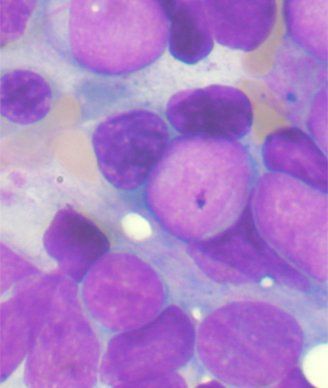MRD, Remission Independent Prognostic Factors for AML
In patients with AML, post-therapy parameters including minimal residual disease and remission were found to be independent prognostic factors for outcomes.
Bone marrow aspirate showing AML. Image source: Tontoni, Wikimedia Commons.

In patients with acute myeloid leukemia (AML), post-therapy parameters including minimal residual disease (MRD) status were found to be independent prognostic factors for outcomes, according to the results of a retrospective study published recently in the Journal of Clinical Oncology.
According to the study, many commonly assessed patient covariates have limited predictive value for AML. Instead, researchers have begun to evaluate information gained after treatment, such as response to therapy, to estimate risk for relapse and survival.
In this study, Xueyan Chen, MD, PhD, of the University of Washington, and colleagues evaluated the relationship between MRD and clinical response, such as complete remission (CR), CR with incomplete platelet recovery (CRp), and CR with incomplete blood count recovery (Cri) to determine if these parameters had independent effects on outcomes for patients with AML.
“Our study seems to be the first to demonstrate a significant correlation between MRD and response; patients who achieved [CR] with incomplete blood count recovery (CRp or CRi) more frequently had MRD and higher levels of MRD than patients achieving CR,” wrote Chen and colleagues. “This finding suggests that failure of blood count recovery may result from inadequate treatment of AML, as well as the more commonly assumed toxicity to normal progenitors.”
The researchers looked at data from 245 adults with AML who achieved CR, CRp, or CRi; 165 patients had newly diagnosed disease and 80 had relapsed or refractory disease. Seventy-one percent of patients achieved a CR, 19.6% achieved CRp, and 9.4% achieved CRi.
Data indicated that the 71% of patients who achieved CR had MRD less frequently and had lower levels of MRD than patients achieving CRp and CRi (0.5% vs 1.1% vs 2.7%).
“Although monosomal karyotype, FLT3 ITD mutation, and relapsed or refractory AML are assumed to be associated with greater risk of relapse, whereas favorable cytogenetics are assumed to be associated with a reduced risk of relapse, and were found to be so in our univariable analyses, these factors lost much of their significance once MRD and response were taken into account,” the researchers wrote.
This finding indicates that any risk assessment done at diagnosis of multiple myeloma should be adjusted to take into account post-therapy data. Specifically, CR, CRp, and CRi are all independent prognostic factors for relapse, overall survival, and recurrence-free survival in AML.
“Information about these post-treatment factors is likely more important than information about several traditional pretreatment prognostic factors and should play a major-and perhaps the dominant-role in planning postinduction therapy,” the researchers wrote.
Highlighting Insights From the Marginal Zone Lymphoma Workshop
Clinicians outline the significance of the MZL Workshop, where a gathering of international experts in the field discussed updates in the disease state.